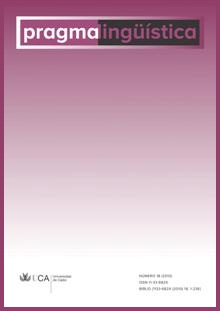El tiempo verbal en la interpretación de enunciados

DOI
https://doi.org/10.25267/Pragmalinguistica.2010.i18.06Información
Resumen
Este trabajo propone caracterizar el concepto de tiempo en el marco de la Teoría de la Relevancia (TR), y explorar las posibilidades de aplicación expuesta en esta noción en el marco de la interpretación que realiza el destinatario de un enunciado. Se intenta establecer cómo los rasgos procedimentales que caracterizan al tiempo verbal ocasionan procesos inferenciales que llevan a interpretaciones de los tiempos con valores modales.
Palabras clave
Descargas
Cómo citar
Licencia
Derechos de autor 2018 Pragmalingüística

Esta obra está bajo una licencia internacional Creative Commons Atribución-NoComercial-CompartirIgual 4.0.
Citas
AHERN, A & M. LEONETTI (2004). “Procedural Semantics and Pragmatic Inference”. Current Trends in the Pragmatics of Spanish. Ámsterdam : John Benjamins: pp. 35-36.
BENVENISTE, E. (1959). “Les Relations de Temps dans le Verbe Français”. Bulletin de la Societé de Linguistique de Paris. 54 : pp. 69-82.
— (1971). “Estructura de las relaciones de persona en el verbo”. Problemas de lingüística general I. México. Siglo XXI: pp. 161-171.
BROWN, P. & S LEVINSON (1978). Questions and Politeness: Strategies in Social Interaction. Cambridge: Cambridge University Press.
— (1987). Politeness: Some Universals in Language Usage. Cambridge: Cambridge University Press.
BÜHLER, K. (1979). Teoría del lenguaje. Madrid: Alianza.
CARSTON, R. (1998). “The Semantics/Pragmatics Distinction: A View from Relevance Theory”. UCL Working Papers in Linguistics. 10: pp. 303-329.
— (1999). “The Semantics/Pragmatics Distinction: A View from Relevance Theory”. En K. TURNER (ed.). The Semantics/Pragmatics Interface from Di erent Points of View (CRiSPI 1). Elsevier Science: pp. 85-125.
— (2000). “Explicature and Semantics”. UCL Working Papers in Linguistics. 12: pp. 1-44.
CHOMSKY, N. (1981). Lectures on Government and Binding. Dordrecht: Foris.
— (1995). The Minimalist Program. Cambridge: MIT Press.
— (1998). “Minimalist Inquiries: The Framework”. MIT Occasional Papers in Linguistics, 15. Cambridge: MIT Press.
— (2001). “Derivation by Phase”. En M. KENSTOWICZ & K. HALE (ed.). A Life in Language. Cambridge (Mass.). MIT Press: pp. 1-52.
— (2005). “On Phases”. En C. OTERO et al. (eds.). Foundational Issues in Linguistic Theory. Cambridge (Mass.): MIT Press.
ESCANDELL VIDAL, M. V & M. LEONETTI (1997). “Categorías funcionales y semántica procedimental”. En M. MARTÍNEZ HERNÁNDEZ et al. (eds). Actas del Congreso Internacional de Gramática. Madrid. Ed. Clásicas: pp. 363-378.
RICE, H.P. (1975). “Lógica y conversación”. En L. M. VALDÉS VILLANUEVA (Comp.). 1991.
KERBRAT-ORECCHIONI, C. (1988). La enunciación. De la subjetividad en el lenguaje. Buenos Aires: Hachette.
JACKENDOFF, R., (1990). Semantic Structures. Cambridge: MIT Press.
LEONETTI, M. (2001). “Gramática y Teoría de la Relevancia” ms. UNR.
— (2002). “Sobre tiempos y determinantes”. En M. VILLAYANDRE LLAMAZARES (coord.). Actas del V Congreso de Lingüística General. León: Universidad de León.
— (2004a). “Specificity and Di erential Object Parking in Spanish”. En Catalan Journal of Linguistics. 3: pp. 2004 75-114
— (2004b). “Por qué el imperfecto es anafórico” En B. CAMUS Y L. GARCÍA
FERNÁNDEZ (eds.). El Pretérito Imperfecto. Madrid: Gredos: pp. 481-507.
LEONETTI, M. & M. V. ESCANDELL VIDAL (2004). “Semántica conceptual/Semántica procedimental”. En M. VILLAYANDRE LLAMAZARES (coord.). Actas del V Congreso de Lingüística General. Madrid: Arco.
ROMERO, D. (2007a). “Tiempo y estructuras lingüístico-comunicativas”. VII Congreso Nacional y II Congreso Internacional de Semiótica. Rosario. Septiembre 2007.
— (2007b). “El v (verbo ligero) como categoría procedimental.” Jornada sobre Teorías del lenguaje. FAHCE-UNLP. Noviembre de 2007.
— (2008). “Fases en la derivación y categorías procedimentales”. Presentado en el XI Congreso de la SAL, UNL, Santa Fe, abril de 2008.
SPERBER, D & D. WILSON (1986/95). Relevance: Communication and Cognition. Oxford: Blackwell; Cambridge: Mass. Harvard U.P.
VALDÉS VILLANUEVA, L.M. (ed.). (1991). La búsqueda del significado. Madrid: Tecnos.
WEINRICH, H. (1968). Estructura y función de los tiempos en el lenguaje. Madrid: Gredos.
WILSON, D. & D. SPERBER (2004). “La Teoría de la Relevancia”. Revista de Investigación Lingüística. VII, 2004: pp. 237-286.
— (1986). “Sobre la definición de relevancia”. En L. M. VALDÉS VILLANUEVA (ed.)






